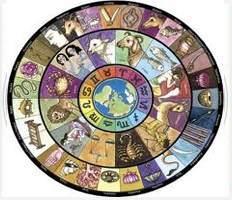- Astrology
- All Dosh
- Abhishek
- Puja Services
- Healings
- Therapies
- Meditation
- Vastu Shastra
- Attunements or ShaktiPaat
Kaal Sarp & Manglik Dosh & Gand Mool
 Kaal Sarp Dosha implies many meanings in Sanskrit, but there is danger and a threat to life associated with the word. Of its many meanings, we can safely conclude that Kaal means time, and Sarp means snake
or serpent.Kaal Sarp Dosh can cast its inauspicious shadow over property, finances and health. If Kaal Sarpa Dosha is not thwarted, its influence makes the simplest of works, the most difficult to perform. Kalasarpa yoga formed
during the transits of Rahu and Ketu plays a vital role in the mundane affairs, generally causing unexpected natural havocs and calamities. According to Vedic astrology different types of Kalasarpa yogas Since Rahu and Ketu
are placed at 180° to one another,
Kaal Sarp Dosha implies many meanings in Sanskrit, but there is danger and a threat to life associated with the word. Of its many meanings, we can safely conclude that Kaal means time, and Sarp means snake
or serpent.Kaal Sarp Dosh can cast its inauspicious shadow over property, finances and health. If Kaal Sarpa Dosha is not thwarted, its influence makes the simplest of works, the most difficult to perform. Kalasarpa yoga formed
during the transits of Rahu and Ketu plays a vital role in the mundane affairs, generally causing unexpected natural havocs and calamities. According to Vedic astrology different types of Kalasarpa yogas Since Rahu and Ketu
are placed at 180° to one another,
they can form twelve different types of Kalasarpa dosha
- Anantha Kala sarpa Dosha
- Kulika Kala sarpa Dosha
- Vasuki Kala sarpa Dosha
- Shankuphala Kalasarpa Dosha
- Padma Kalasarpa Dosha
- Mahapadma Kalasarpa Dosha
- Takshaka Kalasarpa Dosha
- Karkotaka Kalasarpa Dosha
- Shanchachud Kalasarpa Dosha
- Ghataka Kalasarpa Dosha
- Vishdhana Kalasarpa Dosha
- Sesh-naga Kalasarpa Dosha
Manglik Dosh
 In Hindu astrology , Mangal Dosha is an astrological combination that occurs if Mars (Mangal) is in the 1st, 2nd, 4th, 7th, 8th, or 12th
house of the ascendant chart. A person born in the presence of this condition is termed a manglik
In Hindu astrology , Mangal Dosha is an astrological combination that occurs if Mars (Mangal) is in the 1st, 2nd, 4th, 7th, 8th, or 12th
house of the ascendant chart. A person born in the presence of this condition is termed a manglik
It is believed to be unfavourable for marriages, causing discomfort and tension in relationship, leading to severe disharmony among the spouses and eventually to other bigger problems. This is believed to be caused due
to the "fiery" nature of the planet Mars, named after the Roman god of war. Also, if two mangliks marry, the negative effects are believed to cancel each other out. However, Mars is not the only planet in Astrology that is
supposed to affect the relationship and these effects should be seen in a broader perspective of overall astrological compatibility
There is a belief that the negative consequences for a single-manglik marriage can be resolved if the manglik first performs a ceremony called a kumbh vivah, in which the manglik "marries" a banana tree, a peepaltree,
or a silver or gold idol of the Hindu God Vishnu
The bad effects of Mangal Dosh can be reduced with the help of astrological remedies which would generally include the application of Pooja, Mantras, Gemstones and Charities and these remedies are different for different
individuals depending upon their horoscopes
Gandmool dosha
 The existing 12 rashi has normally 27 nakshaktra in which a person is born. Out of these 27 nakshaktra, 6 are called gandmool. These nakshaktras
are Ashvini, Revati, Magha, Ashlesha, Moola or Jyeshtha nakshatra. Gand actually is Gant which means Knot. Only a few Nakshatras fall in this category and even then, it depends in which Charan of the 4 charans the child is
born. Which means that placement of the Moon in 6 out of 27 Nakshatras confirms the formation of this defect according to its general definition.
The existing 12 rashi has normally 27 nakshaktra in which a person is born. Out of these 27 nakshaktra, 6 are called gandmool. These nakshaktras
are Ashvini, Revati, Magha, Ashlesha, Moola or Jyeshtha nakshatra. Gand actually is Gant which means Knot. Only a few Nakshatras fall in this category and even then, it depends in which Charan of the 4 charans the child is
born. Which means that placement of the Moon in 6 out of 27 Nakshatras confirms the formation of this defect according to its general definition.
This defect named GandMool Dosh is formed only if the Moon is placed in one of the following :
- 4th Pada of Revati Nakshatra.
- 1st Pada of Ashvini Nakshatra.
- 4th Pada of Ashlesha Nakshatra.
- 1st Pada of Magha Nakshatra.
- 4th Pada of Jyeshtha Nakshatra.
- 1st Pada of Moola Nakshatra.
If the natal Moon in the horoscope of a child is in one of these Nakshatras, the child is said to be born in Gand Mool Nakshatras. Gand mool forms Arishta Yoga. Arishta means suffering and it is said that the child has to suffer in certain years of his life. The child born under gandmool doesn't only remain sad but he also becomes the root for the family misery. Some have the views that if the child is born in such Nakshatras, it signifies death of cattle, bad by heart, bad for maternal uncle, bad for elder brother, bad for spouse, death of father and death of mother etc. These nakshatras are ruled by the planets Mercury & Ketu.





































